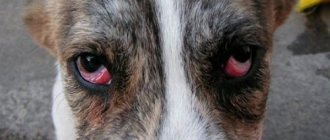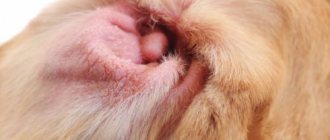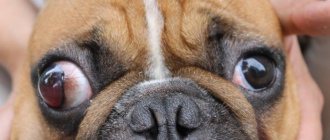Owners most often turn to veterinary clinics with red eyes in dogs. This clinical sign may not indicate a specific disease or reflect its severity. Red eye syndrome can be caused by various pathologies affecting the structures of the organ of vision, as well as other systems. Often, only red eyes are recorded in a dog (glaucoma, uveitis), but more often there are other signs that allow diagnosis and treatment.
Causes of red eyes in dogs
The causes of red eyes in a dog can be of different nature: heredity, infectious and non-infectious diseases, injuries, and so on. In addition, redness can be local or widespread, observed for a short period of time or for a long time, accompanied by accompanying symptoms or be the only sign of pathology.
Infectious diseases that cause red eyes
This group of causes of red eyes includes contagious diseases caused by viruses, bacteria, and fungi.
- Chlamydia. It often occurs in a chronic form. The eyes are affected alternately. If left untreated, uveitis can develop, which ultimately results in blindness.
- Viral diseases of puppies. Red eyes are usually accompanied by diarrhea, vomiting, high body temperature and loss of large amounts of fluid from the body.
- Toxoplasmosis. Delayed assistance leads to the development of uveitis, just like with chlamydia. Newborn dogs usually do not survive, and infected pregnant females often experience spontaneous abortions.
- Telaziosis. This is a parasitic disease; Thelyasia are spread by flies. Feeding on the dog's eye secretions, the flies are carried to the mucous membrane of the larvae. Redness of the eyes is accompanied by clouding, inflammation of the eyelids, conjunctiva, and loss of vision.
- Conjunctivitis. This is an inflammatory process in the connective membrane of the dog’s eye, which occurs for a variety of reasons. Viral or bacterial conjunctivitis is contagious to other animals and humans. Depending on the nature of the disease, redness of the eyes is accompanied by various accompanying symptoms.
- Keratitis. With this disease, the cornea becomes inflamed. As in the previous case, the pathology has a different nature. In addition to red eyes, the dog has: increased secretion of tear secretion, thickening of the eyelids, deposition of calcium salts, and possible formation of pus in the organs of vision.
- Plague. The dog's eyes turn red at the same time as the lungs are affected. At the same time, the lymph nodes enlarge, vomiting and diarrhea appear, body temperature rises, and the eyes fester. The disease can lead to the death of the pet.
Non-infectious pathologies
Red eyes in a dog can be the result of non-contagious diseases and conditions.
- Mechanical injury. Can be obtained during a fight with another dog or cat; the dog may accidentally damage his eyes with a branch; Seeds or other small objects may enter the organs of vision.
- Inversion and eversion of the eyelids. In the first case, the hairs located on the eyelid irritate the cornea of the eye, which over time can lead to poor vision and blindness. In the second, the mucous membrane falls out, which provokes the penetration of infectious agents into it. The pathology is often genetically determined and is observed, for example, in bulldogs and sharpeis.
- Blepharitis. Depending on the provoking factor (trauma, parasites, etc.), the disease may be contagious or not. In addition to the fact that the dog’s eyes are red, they fester, water, and stick together.
- Prolapse (prolapse) of the third eyelid. This is a pathological condition in which the nictitating membrane (the third eyelid that includes the tear gland) covers part of the dog's eye in the form of a pinkish or red film. It prevents the eyes from closing, causes itching, redness of the whites, provokes infections and the development of inflammation. Most often transmitted genetically.
- Diabetes. Dogs with diabetes may have red eyes due to spikes in blood glucose. In this case, the blood vessels become thinner and damaged - they rupture and hemorrhage. Associated symptoms: dull coat, dry mucous membranes (including eyes), rapid heartbeat, the animal drinks a lot.
- Blockage of the tear duct. Leads to the appearance of red eyes and frequent inflammatory processes.
- High blood pressure. Causes blood vessels in the dog's eyes to become overflowing with blood and turn red. Over time, it can cause vision deterioration or loss.
- Malignant and benign formations. Various tumors (bumps) can also cause red eyes, having a mechanical, hormonal or other effect on the organs of vision. In older dogs, adenoma of the third eyelid often develops.
- Allergic reaction. Red eyes are accompanied by itching of varying intensity, swelling of the mucous membrane, copious secretion of tear secretion, and sneezing. An allergen can be any irritant - pollen, medications, ingredients of feed mixtures, hygiene products.
Red eyes as heredity
In some cases, red eyes in a dog are normal. This occurs if the pet is an albino or belongs to one of the breeds that are genetically predisposed to reddening of the proteins of the organs of vision. These include the bulldog, cocker spaniel, Pekingese, pug, basset hound and others. In this case, it is not the redness itself that is inherited, but the diseases in which this occurs, for example, inflammation of the conjunctiva.
Red eyes as a normal response of the body to stress
In a number of situations, a dog’s eyes become red under the influence of some stress factor. For example, with excitement (moving, fear, aggression), the blood vessels in the eyes can dilate, which visually manifests itself as redness. As the pet calms down, the phenomenon goes away on its own.
The same thing occurs with prolonged exposure to the sun or in an overheated, stuffy room. Blood rushes to the eyes, shortness of breath appears, the dog loses coordination and is poorly oriented in space, may lose consciousness, vomiting and/or bleeding from the nasal passages is possible. In such cases, the pet needs urgent help: you need to give it water, pour it on top, put a wet cloth (ice) on its head, and place it in a cool, well-ventilated place.
Sometimes red eyes in a dog are observed after a walk, if there is a strong wind outside, especially with dust. When small particles get on the membrane of the organs of vision, irritation of the mucous membrane occurs, its dryness, which leads to redness.
Prevention
- monthly (annual) deworming (getting rid of helminths and the causes that can cause them);
- vaccination (prevention of infection with infectious, invasive, viral and autoimmune diseases);
- eliminating the causes that can cause or are causing an allergic reaction;
- the correct choice of walking areas for the animal so that the animal cannot be injured, become infected with helminths and other diseases transmitted from living organisms;
- monitor the state of the environment. If the temperature outside is higher or lower than normal, then make sure that the dog does not get overheated or hypothermic;
- the most important thing: if you notice any deviations in the dog’s behavior, or symptoms appear that were not noticed before, then immediately contact a veterinary clinic, where you will be provided with high-quality and specialized care.
If you still could not protect your dog from the negative effects of the environment and it acquired any disease, then you need to start treatment immediately.
Associated symptoms
What symptoms should you look out for if your dog has red eyes? To make the diagnosis as accurate as possible, before visiting a veterinarian, the owner needs to take a close look at his four-legged friend. Be sure to inform your specialist about the following accompanying symptoms:
- difficulty opening eyes, eyelids sticking together;
- purulent or other discharge;
- profuse lacrimation;
- itching (the dog often rubs the organs of vision);
- pupil disproportion;
- fear of light;
- the appearance of spots, haze, neoplasms on the cornea, iris, eyelids;
- swollen eyelids;
- elevated body temperature.
You should also pay attention to the general condition of the animal: is it hiding in a secluded place, is it scared or has become aggressive and irritable, is it weakened, is there discharge from the nostrils or difficulty breathing, and so on. Even a seemingly insignificant clarification or detail will make it possible to undergo the necessary examination, make the correct diagnosis and quickly begin treatment.
How to treat red eyesight in a dog
In most cases, treatment of red eyes in a dog is carried out using external means - ointments, drops and rinsing solutions. In difficult situations (depending on the disease), injections are prescribed. In therapy, drugs of different groups can be used: antibacterial, antiviral, anti-inflammatory, antifungal, antiseptic, regenerative, immunostimulating and others. At the same time, vitamin-mineral complexes and physiotherapeutic measures can be prescribed.
The most popular external remedies are:
- Anandin – reduces inflammation, has an antiseptic effect, heals tissue;
- Sulfacyl sodium – antibacterial effect;
- Leopard - exhibits a powerful antiseptic effect, eliminates pain, prevents the development of secondary infections, contains an antibiotic, and can also be used for prophylaxis;
- Diamond eyes – antimicrobial drops, stimulate the healing of damaged tissues, eliminate inflammation;
- Maxidin – has immunostimulating activity;
- Iris is a healing, anti-inflammatory, antibacterial agent, especially effective for ulcerative lesions of the cornea;
- Sofradex - constricts blood vessels, eliminates the inflammatory process, destroys infection;
- Tsiprovet – has a pronounced antibacterial effect;
- Tetracycline ointment is an antibacterial, anti-inflammatory drug, effective against chlamydia;
- Furacilin is an antiseptic, used to wash the eyes.
Features of the treatment of red eyes in a dog for certain diseases and conditions are described in the table below.
Disease/condition
How is the treatment carried out?
Toxoplasmosis
Anandin (Maksidin) is instilled into the pet's eyes. At the same time, immunomodulatory injections are prescribed.
Thelaziosis
To destroy thelyas, a large amount of 3% boric acid is instilled into the animal’s eyes once every 25 days throughout the summer.
Conjunctivitis
Bars is used in the form of drops.
Inversion (inversion) of the eyelids
Conservative treatment consists of using hormonal ointments, such as hydrocortisone. Or surgery is performed.
Presence of a foreign body
An extraction is made, after which the eye is washed with an antiseptic and ointment is applied.
Third eyelid prolapse
Treatment consists of removing the pathology surgically. Since the lacrimal gland is also removed, the animal is prescribed drops to moisturize the mucous membrane of the eyes for the rest of its life.
Facilities
Drops
What medications are suitable for pus and other problems:
- Diamond . Pros: effective, universal, easy to use, non-addictive, good for prevention. Disadvantages: they run out quickly, with constant use, individual intolerance to the drug is possible, the animal may not like the procedure.
- Bars . Pros: has a good therapeutic effect, helps prevent eye inflammation due to injuries, price-quality ratio, quick results. Disadvantages: individual intolerance; if you miss a dose, the therapeutic effect is reduced.
- Iris . Inexpensive, effective. Disadvantage: contains an antibiotic that has side effects.
Ointments
- Optimmune . Effectively used to treat eye diseases of autoimmune etiology in dogs. May be used to enhance or replace topical corticosteroids. Contraindications: in case of allergic reactions, use is discontinued. Not suitable for use in productive animals. It is prohibited to use for fungal and viral infections. Side effects: in the first days of use, irritation is possible. If it does not go away, stop taking it. In rare cases, there is inflammation and swelling of the skin of the eyelids caused by excessive amounts of ointment.
- Tetracycline . It is used to treat a wide variety of diseases. Available without a prescription. Cons: cannot be used during pregnancy. For diseases of the kidneys, liver and blood. And with individual intolerance. Cannot be used before a certain age.
Anti-inflammatory drugs
Used in combination with other medications, but only as prescribed by a veterinarian. Relieves pain and inflammation inside the eye. Use depends on the cause of the disease. Should not be used for infectious diseases.
How to give first aid
Until you visit a veterinarian, you can relieve your pet’s condition on your own. First aid measures are as follows:
- if there is pus or other discharge, or if household chemicals get into your eyes, rinse them well with warm water;
- if the mucous membrane of the organs of vision is dry, it is necessary to instill a means to moisturize it, for example, Natural Tear;
- if very severe redness is observed, you can use Ciprovet.
You cannot use any drugs based on antibacterial, antifungal, hormonal or other active ingredients on your own! Such “treatment” can cause complications and lead to vision loss.
What to pay attention to during treatment
For a speedy recovery of your four-legged friend and to avoid complications, experts recommend the following:
- Before the dog is examined by a veterinarian, the eyes can only be washed with water, weak tea, or furatsilin solution;
- a visit to a specialist is necessary even if there are no associated symptoms;
- do not try to “examine” the pathology yourself, as there is a risk of causing a secondary infection or becoming infected from a pet;
- wash with rubber gloves; after the procedure, wash your hands thoroughly with soap.
The sooner the animal is examined by a doctor, the greater the chance of avoiding complications and maintaining vision.
How to wash your dog's eyes
To wash your dog’s eyes, you need to moisten a cotton wool disc or a piece of gauze (soft cloth) in a pre-prepared solution or regular boiled water. The solution should be at room temperature. Movements are made in the direction from the outer corner of the eye to the bridge of the nose. If there are dried crusts on the eyelids, apply a generously moistened disc to them several times, holding for 2-4 seconds. You need to apply the compress until the crusts get wet, after which they are carefully removed with a new, wetted and wrung-out disc.
Why do you need diagnostics in a veterinary clinic?
Diagnosis in a veterinary clinic is necessary to exclude diseases with similar symptoms and select effective, and most importantly, safe treatment. A set of laboratory and instrumental studies helps to identify the exact cause of the ailment. These include:
- tests of urine, blood and feces, revealing deviations in baseline indicators and the presence of parasites;
- bacteriological culture, used to determine the exact type of pathogen and drugs to destroy it;
- measurement of intraocular pressure;
- Ultrasound of the abdominal cavity, determining the presence of pathologies of internal organs;
- allergy test;
- X-ray of the chest and skull, which helps detect closed injuries;
- Schirmer test, which allows you to determine the level of tear production.
The list presented can be supplemented or shortened by a veterinarian. After receiving all the results, an individual treatment plan is selected for the animal.
Preventive measures
To prevent red eyes in a dog, you need to pay attention to the following points:
- increase your pet’s immunity, provide balanced nutrition;
- walk in a safe place;
- prevent unnecessary “acquaintances”;
- avoid stress;
- carefully select hygiene products;
- destroy parasites in a timely manner;
- get vaccinated on time;
- promptly contact a veterinarian without delaying treatment of diseases.
Periodic examination of the dog's eyes, careful attention to it, its behavior and mood, as well as a quick response to changes in health will serve as the key to a long and healthy life for your pet.
Diseases and problems of the lens
Pathologies of this category in veterinary ophthalmology are considered the most dangerous for dogs of all breeds. Animals of any age category suffer, regardless of gender, health status, or breed.
Any disease of the eye lens is detected based on clouding of the protein and signs of visual impairment. The prognosis for such diseases is unfavorable, since there is practically no productive therapy for lens pathologies.
Cataract
One of the most common and most unpromising diseases in terms of treatment is cataracts. This disease most often occurs in the following age groups of dogs:
- puppies under 1 year of age;
- adults starting from 8 years of age.
Between the ages of one and eight years, animals are at risk of developing cataracts. The juvenile form of cataracts is more typical for breeds such as:
- dachshund;
- poodle;
- Labrador;
- bull terrier;
- Staffordshire Terrier.
The age-related form of cataracts in dogs after 8 years can develop in all breeds. This ophthalmological problem occurs against the background of primary diseases: for example, with progressive glaucoma, dysplasia or retinal atrophy.
Treatment methods for this disease have not been developed for dogs. A surgical operation may be performed to:
- removal of damaged eye lens;
- implantation of an artificial lens.
Currently, cataract surgery is performed using ultrasound technology, as well as phacoemulsification, a minimally invasive operation using a microscopic incision.











